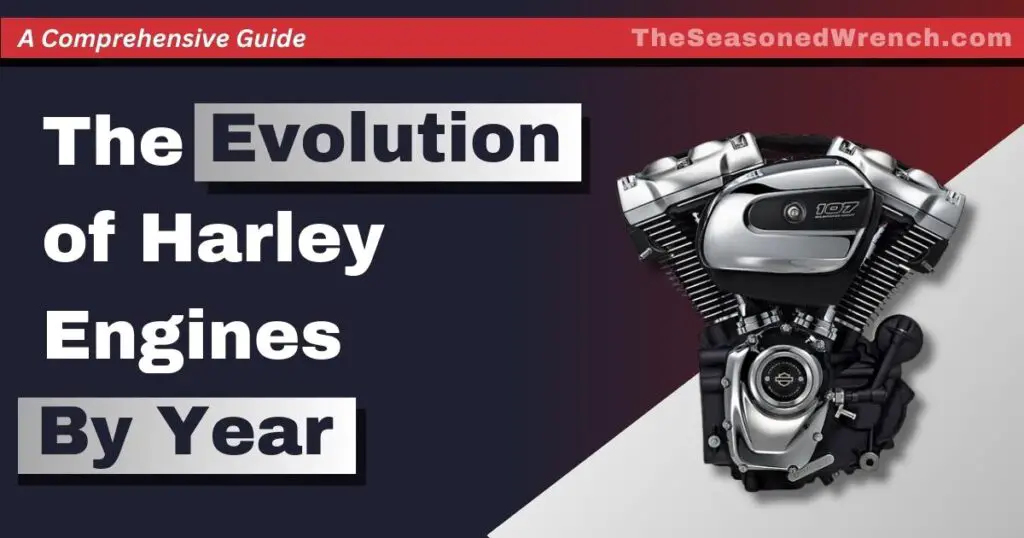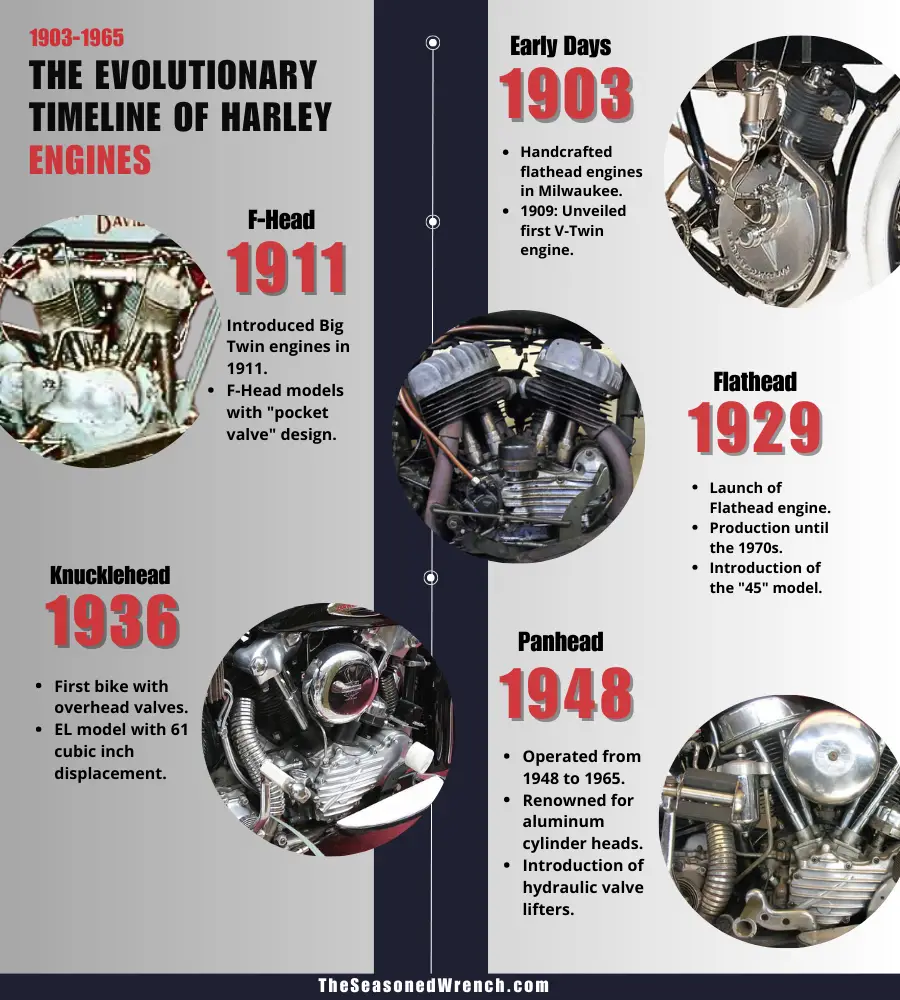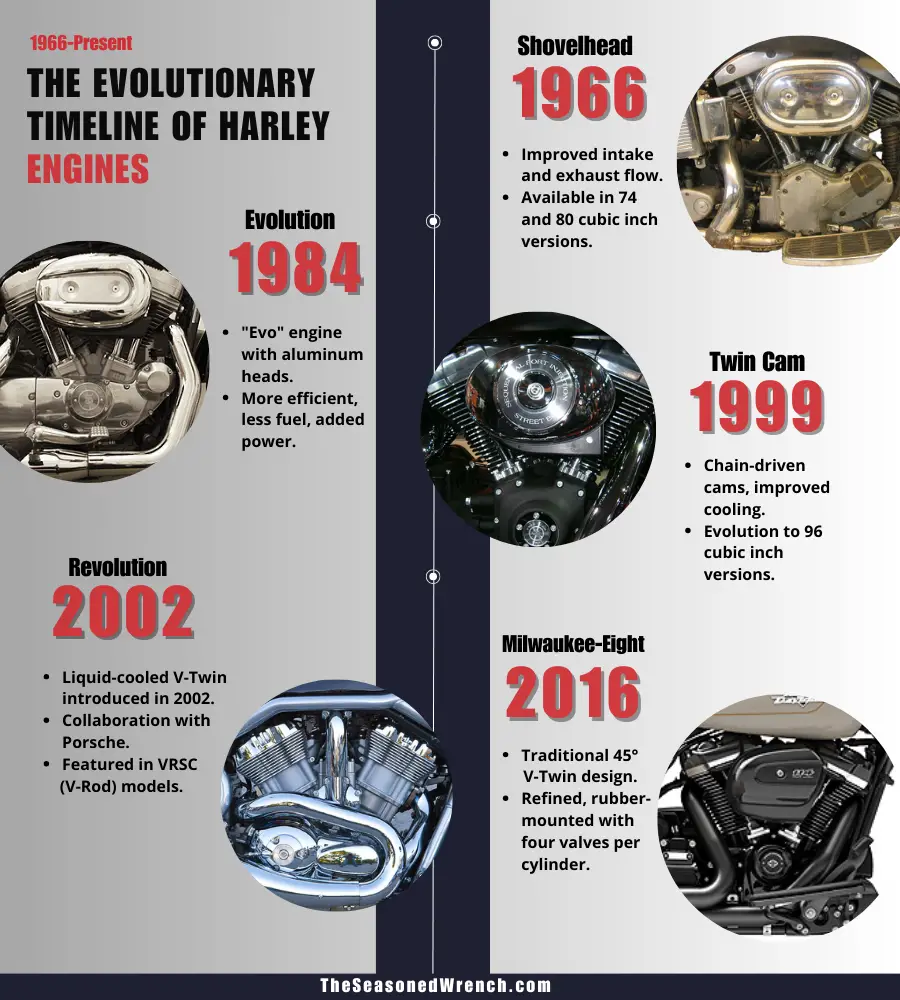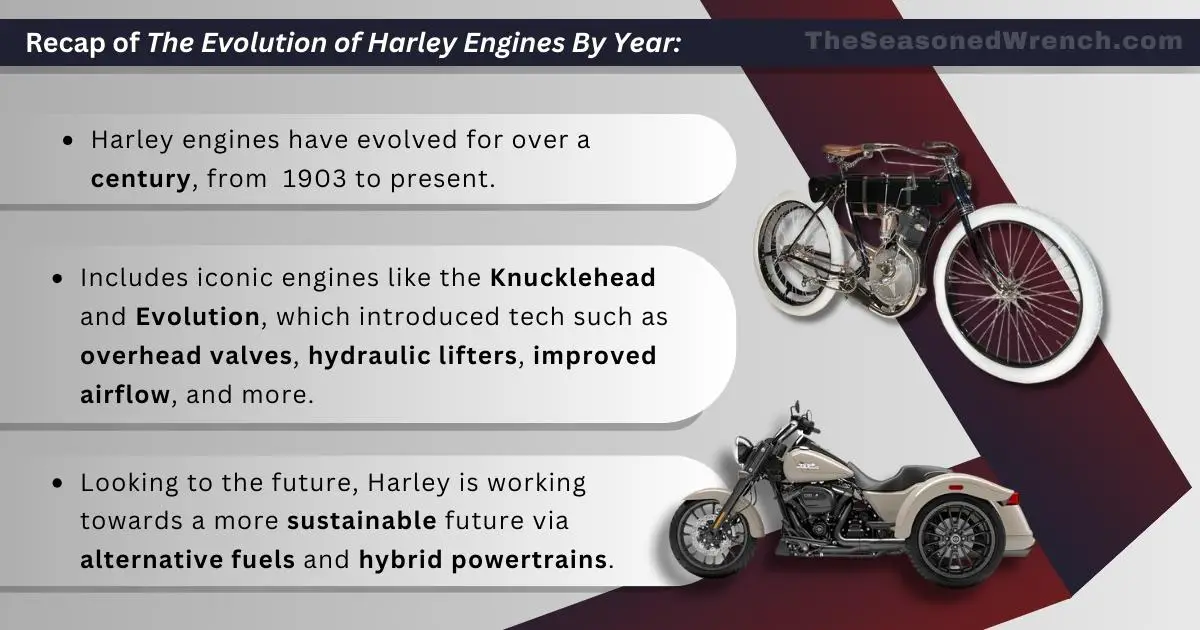
Key Points
- Evolution of Harley Engines: This guide covers the progression of Harley engines by Year, from the early F-Head to the modern Milwaukee-Eight, highlighting the brand’s commitment to innovative engine design.
- Iconic Engine Designs: It delves into the distinctive features and technological advancements that have made Harley engines a symbol of prestige in motorcycle culture.
- Transition from Simple to Complex: The article traces Harley’s journey from single-cylinder models to more complex V-Twin designs, showcasing the brand’s evolution and excellence in engineering.
- Each Engine’s Unique Story: It emphasizes that every Harley engine, from the Flathead to the Revolution series, is not just about power but also represents a deep-rooted part of the brand’s history and the motorcycle world.
Harley-Davidson’s engines, synonymous with the American spirit of freedom and adventure, have been at the forefront of motorcycle engineering for over a century. This guide presents a detailed look at these legendary engines, from the early F-Head to the cutting-edge Milwaukee-Eight, highlighting the company’s dedication to proprietary engine designs.
We will explore the distinctive features and technological advancements that have made Harley engines iconic in the motorcycle world. The transition from the simpler single-cylinder engine models to the more complex V-Twin engine designs is a testament to the Harley-Davidson brand and its commitment to innovation and excellence. These engines are not just about power; they are symbols of prestige and a resonant part of the motorcycle culture.
Join us as we explore this rich history, where each engine rev is not just a mechanical function but a powerful expression of a legendary brand.
And away we go!
A Breakdown of Harley Engines By Year: An Evolutionary Timeline

1. The Early Days (1903-1911)
The journey of Harley-Davidson motors began in Milwaukee, Wisconsin, where the Harley family handcrafted flathead engines and introduced them to the world by fitting them to bicycles.
The single-cylinder model in 1903, derived from the De Dion-Bouton engine, marked the beginning of the Harley Davidson legacy in engine design. This initial design featured a 3-1/8 inch bore and a 3-1/2 inch stroke, producing about 7 horsepower (HP) from its small cubic inch displacement, and was equipped with atmospheric intake valves and a leather belt drive.
In 1909, Harley-Davidson unveiled its first V-Twin engine, a significant milestone in motorcycle engineering that delivered more power and set the stage for future innovations in larger cubic inch engines.
Harley models equipped with the single-cylinder engine:
- Single
- Model 1
- Model 2
- Model 3
- Model 4
2. The F-Head Era (1911-1929)
The F-Head models, the first Big Twin engines from Harley-Davidson, were introduced in 1911, marking a significant development in Harley engines. These were IOE (intake/inlet over exhaust) type motors, available in 61 cubic inch and 74 cubic inch sizes, with either 1000cc or 1210cc options.
Featuring a “pocket valve” design with an overhead intake valve and a side-mounted exhaust valve, these hand-cranked F-head engines were foundational in Harley’s lineup until their last year of production in 1929.
Models equipped with the F-Head engine:
- Model 7D
- JD Series
- FD
- JDH
- J
3. The Flathead Era (1929-1973)
Harley-Davidson motor company launched the Flathead engine in 1929, notable for its flat-topped, vented cylinder heads and sideways-arranged valves for easy servicing.
Initially introduced as a 45 cubic inch motor, the 74 cubic inch model appeared in 1930. These engines, optimized in various capacities up to 1340cm³ and 34 HP, powered motorcycles and the three-wheeled Servi-Cars, with the Flathead remaining in production until the 1970s. The era was marked by the introduction of the “45” model, a key component in Harley’s Flathead legacy.
The Harley Davidson Flathead era also saw the introduction of the “45” model, a 45 cubic inch V-twin flathead engine, a staple in Harley-Davidson flathead history.
Models equipped with the Flathead engine:
- VL
- U series
- W series
- WL
- Servi-Car
Want to hear a Flathead fire up? Check out the below video:
4. The Knucklehead Era (1936-1947)
The Knucklehead engine, launched in 1936, was the first production Harley Davidson bike with overhead valves, a significant step in the evolution of Harley-Davidson engines.
The Knucklehead engines introduced a recirculating oil system and featured an increased engine size in the EL model with a 61 cubic inch displacement. These engines, named for their distinct rocker boxes, laid the foundation for future Harley-Davidson designs with overhead valves.
Models equipped with the Knucklehead engine:
- EL Knucklehead
- FL Knucklehead
- E
- F
5. The Panhead Era (1948-1965)
The Panhead engine, which operated from 1948 to 1965, was renowned for its aluminum cylinder heads and unique rocker boxes resembling cake pans.
This engine, delivering 60 hp and offered in both 61 and 74 cubic inch versions, was a key component in the Electra Glide models and the first to feature new aluminium cylinder heads, hydraulic valve lifters, revolutionizing the Harley-Davidson valve train design.
Models equipped with the Panhead engine:
- Hydra-Glide
- Duo-Glide
- Electra-Glide
- FL Panhead
- EL Panhead

6. The Shovelhead Era (1966-1984)
The Harley Davidson Shovelhead engine, produced from 1966 until 1984, was named for its distinct ‘shoveled-out’ rocker covers. Available in 74 and 80 cubic inch versions, this era of Harley engines introduced significant improvements in intake and exhaust flow, enhancing the engine’s cooling and performance.
The Harley Davidson Shovelhead engines powered a variety of models, including the popular Dyna and Softail models.
Read more about the Panhead and Shovelhead: Shovelhead vs Panhead: A Harley Davidson Engine Showdown
Models with equipped with the Shovelhead engine:
- Electra-Glide
- Super Glide
- Low Rider
- Fat Bob
- Wide Glide
Read next: Shovelhead vs Panhead vs Knucklehead (Trip Through Time)
7. The Evolution Engine Era (1984-1999)
The Evolution engine, introduced in 1984, marked a new chapter in Harley Davidson engine history. Known as the “Evo” engine, or the “Blockhead” for its block shaped cylinder heads, this Computer-Aided Designed engine featured aluminum heads and cylinders and was available in 80 cubic inch (1340cc) displacement.
The Harley Davidson Evolution engine was more efficient, used significantly less fuel, and generated added power and more torque than its predecessors, marking a major leap in Harley motor design.
Models equipped with the Evolution engine:
- Softail
- Fat Boy
- Heritage Softail
- Dyna Glide
- Sportster
8. The Twin Cam Motor Era (1999-2017)
In 1999, Harley Davidson introduced the Twin Cam motor, it was designed to meet the demands of new Harley-Davidson models, offering more power and improved cooling. Featuring two chain-driven cams, the Harley Davidson Twin Cam engine was a milestone in Harley-Davidson’s twin engine design.
Twin Cam Engine Glossary:
> Twin Cam 88 vs 96: Dual Cam Shootout (What’s Better?)
> Harley 96 vs 103: What’s The Deal?
> Harley 88 vs 96 vs 103: An In-Depth Engine Comparison
> Harley 88 vs 107: An In-Depth Comparison
> Harley 96 vs 107: Performance, Upgrades, and More
> Is The Twin Cam 88 A Good Motor? Yes and No (Here’s Why)
> Is The Twin Cam 96 A Good Motor? Yes and No (Here’s Why)
> Is The Harley 103 A Good Engine? Yes and No (Here’s Why)
> Harley 103 vs 117: The Ultimate Comparison (Who Wins?)
This era also introduced higher compression pistons and two spark plugs per cylinder in the Twin Cam engines, which initially came in the Twin Cam 88 cubic inch (1450cc) displacement and later evolved to 96 cubic inch (1584cc) versions, significantly enhancing their performance. The Twin Cam 96 was also the first Harley to include fuel injection. This fuel injection was specifically released with the Electra Glide in 1995.
Read more about the Twin Cam and Evolution Engines: Harley’s Twin Cam vs Evo: Who Reigns Supreme? (Revealed)
Models equipped with the Twin-Cam engine:
- Dyna
- Softail
- Touring
- Fat Boy
- Heritage Softail
Check out the below video review of Harley’s Twin Cam 88 motor:
9. The Revolution Era (2002-2017)
A significant departure from traditional Harley-Davidson engine designs, the Revolution engine, introduced in 2002, is a liquid-cooled 60-degree V-Twin powerhouse. Developed in collaboration with Porsche, this engine showcased Harley’s capability to innovate beyond its own proprietary motor designs.
The Revolution engine, standard in the VRSC (V-Rod) models, brought a high-revving capacity to Harley engines, producing 115 HP and introducing a new level of performance to the Harley-Davidson lineup.
Models equipped with the Revolution engine:
- V-Rod
- Street Rod
- Night Rod
- V-Rod Muscle
- Night Rod Special
Related: Revolution Max Engine Problems, Overview, Specs and More
10. The Milwaukee Eight Engine Era (2017-Present)
In 2016, Harley-Davidson announced the Milwaukee-Eight engines, a significant advancement in the Harley-Davidson engine timeline. These engines, equipped with the company’s traditional 45-degree V-Twin design, offer more power and torque than their predecessors due to the eight overhead valves that Harley Davidson introduced, when compared to the four overhead valves used in earlier engine series.
Related: Harley 107 vs 114: Milwaukee 8 Worth The Hype? Yes and No
The Milwaukee-Eight engines feature a refined, rubber-mounted design with four valves per cylinder and improved airflow and efficiency. They are a key feature in Harley-Davidson touring models, providing a smoother ride and enhanced rider comfort.
More about the Milwaukee Eight’s improvement over earlier engine designs:
> Twin Cam vs Milwaukee 8: Harley Motor Shootout
> Harley 103 vs 107: Evolutionary Or Just A Step Backwards?
Models equipped with the Milwaukee-Eight engine:
- Touring Models (Street Glide, Road Glide, Electra Glide, etc.)
- Trike Models
- Softail Models (Fat Boy, Heritage Classic, etc.)
Are you a current M8 owner? You may want to check this out: The Best Tuner For Milwaukee 8 114 Engines (+Alternatives)
The Future of Harley-Davidson Engines
The future of Harley-Davidson engines melds tradition with innovation, focusing on enhanced performance, fuel efficiency, and environmental sustainability. Embracing new engine technologies like variable valve timing, electric powertrains, and advanced combustion methods, Harley-Davidson is poised to redefine the motorcycle experience while maintaining its iconic rumble.
The introduction of the electric LiveWire motorcycle signifies the company’s foray into sustainable transport, appealing to a new, eco-conscious generation without sacrificing performance. Concurrently, improvements in internal combustion engines aim for more power, smoother operation, and better fuel economy, aligning with stricter emission standards.
Harley-Davidson’s exploration of alternative fuels and hybrid technologies shows the brand’s commitment to leading the industry’s transformation towards more sustainable energy sources.
Read next: Does Harley Davidson Make Automatic Motorcycles? Yes And No
The Seasoned Wrench: For All Your Motoring Needs
Harley-Davidson’s engine history, spanning over a century, illustrates a consistent evolution in technology and performance. From the early single-cylinder models to the modern Milwaukee, each generation marks a notable leap in design and capability.
